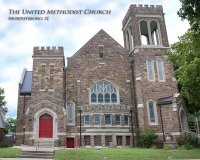The History
of the Murphysboro United Methodist Church
Early Beginnings – The First United Methodist Church was the older of the two Methodist congregations in Murphysboro. On August 25, 1825, the Brownsville Circuit was created, and Josiah Patterson was appointed pastor. Under Patterson’s leadership, camp meetings, located on South 17th Street, were frequent. Peter Cartwright preached at one of these meetings. After Brownsville burned, the town was relocated on the Logan farm property and renamed “Murphysboro.” The Methodist Church moved with the town. For many years the congregation worshiped in a red brick building facing east on 15th Street at the rear of the present building. In 1912-1913, the present building was constructed of native sandstone at a cost of $62,000.
The Split – The origin of the Centenary Methodist Church grew out of the sectional conflict that eventually led to the Civil War. In 1844, a large faction of the Methodist Episcopal Church withdrew from the main body of the denomination. This faction became known as the Methodist Episcopal Church, South. Sermons in both churches often expressed highly partisan political sentiments. After the Civil War, Southern people began to move to Murphysboro to work in coal mines, railroad shops, and other industries and the church grew rapidly. In 1867, the congregation constructed a brick church on the southeast corner of 12th and Locust Street. In 1874, the congregations came upon hard times with the death of their influential and wealthy Elizabeth Jenkins Logan, wife of Dr. John Logan. Due to a shortage in funds, they lost their church. In 1884, they reorganized and on the land donated by General John A. Logan, constructed a frame church at 7th and Walnut, the present site of the Nazarene Church. The church outgrew its facilities, and in 1921, the Methodist Episcopal Church built a brick structure on the corner of 14th and South. The church was renamed “Centenary.”
The Reunion – In 1939, the northern and southern branches of our denomination reunited on the national level. The Centenary and the First Church then served as sister churches of the Southern Illinois Conference of The Methodist Church. Though located only three blocks apart, they both continued in a strong and vital allegiance to the Christian Gospel. The older First Church was characterized as dignified and devout. Centenary was characterized by evangelistic fervor.
The Merger – As the memory of a once bitter conflict receded into the past, deep and abiding friendships emerged between the two congregations. Strength in unity became an ever-increasing allure. In 1966, the Proposal on Union for merger of the two congregations was approved, and in 1968, the merged church constructed an educational building at a cost of $170,207.22. The addition was connected to the former First Church building. The unification was complete in 1968 when the Evangelical United Brethren Church joined the Methodist Church. Now our unified church is celebrating our newest renovation and beautiful building as we look forward to many more years of spreading God’s Word and God’s love.

